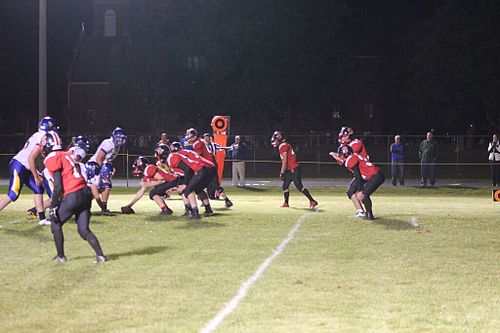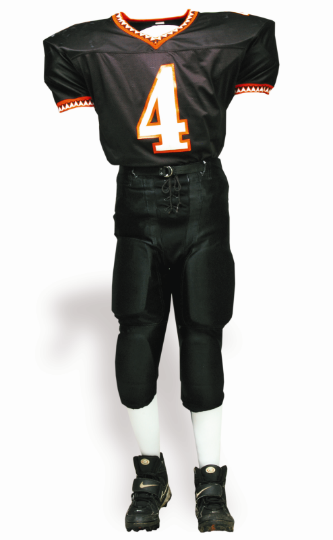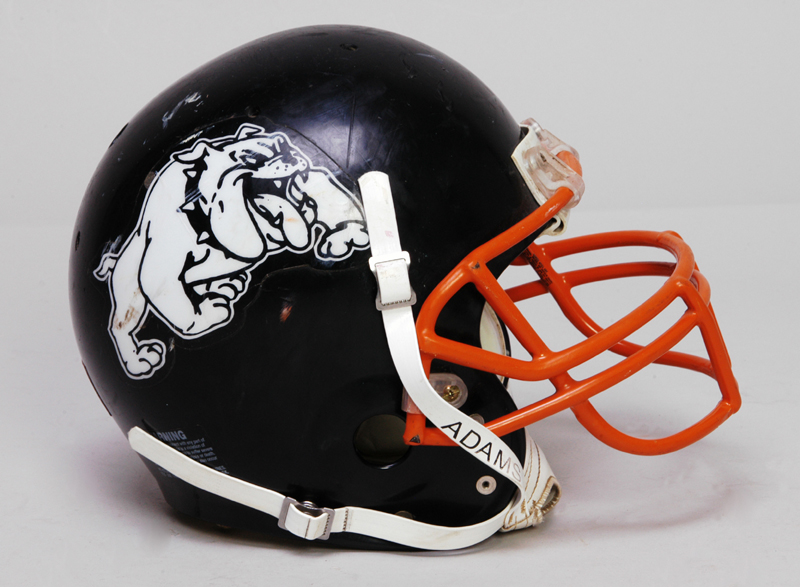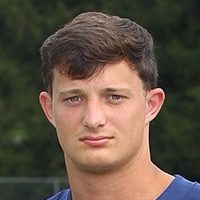Eight-man football is a form of gridiron football, generally played by high schools with smaller enrollments. Eight-man football differs from the traditional 11-man game with the reduction of three players on each side of the ball and a field width that can be reduced to 40 yards, 13 1/3 yards narrower than the 53 1/3-yard 11-man field. Most states continue to play on a 100-yard length field, whereas a few states opt for 80-yard lengths. Reduced-player football, which consists of eight-man, six-man, and nine-man football has gained popularity across the United States. As of 2015, 1,561 schools in 30 states sponsor reduced-player football, with 1,161 of those teams participating in eight-man leagues, whereas 284 teams play six-man football and 116 teams play nine-man football.
Eight Man Football
History
Eight-man football shares the same rules, procedures, and structure as the traditional 11-man game, with a few minor differences. Eight-man football is played with eight players on offense and defense, three fewer than the 11-man game. It depends greatly on the type of formation used, but the eliminated players are commonly two offensive tackles and a skill position player on offense and two defensive backs and a defensive lineman on defense.
The size of the playing field is often smaller in eight-man football than in 11-man. To accommodate six fewer players on the field, the width of the field is 40-yard-wide (37 m), 13 1/3-yards narrower than the 53 1/3-yard eleven-man field. Most eight-man leagues mandate 100-yard length fields, where few choose the 80-yard-long (73 m) field length option.[2]
There are several professional eight-man football leagues in the United States, due to the eight-man format being adopted by most indoor football leagues. These leagues typically use a 50-yard (46 m) by roughly 25-yards (23 m) field, as professional eight-man football is usually played indoors. There are some eight-man leagues that play outdoors, however; in Texas, the American Eightman Football League (AEFL) plays on a 100-yard field, and in Illinois and Missouri, the Eight-Man Football League (8FL) plays on a 60-yard (55 m) field. In recent years, organizations that previously played six-man football have been converting to eight-man football, leading to the expansion of the eight-man game.
Eight-man football is particularly prominent in the Midwestern United States, with Nebraska, Kansas, and Oklahoma being three of the four states with more than 80 eight-man teams. A write-up on 8-man football in Kansas appeared in Sports Illustrated’s tribute to the state.

Rules
Eight-man football consists of fast-paced games with higher scoring than the traditional game. Eight-man scores vary depending on the offensive and defensive strategies, but scores typically fall in the 40-60 point range, with “high scoring” games reaching the 70s and “low scoring” games falling below 30 Eight-man football is noted for producing multi-skilled players that are responsible for playing several positions, which require speed, agility, and strength.
Offense
A variety of offensive formations can be used in eight-man football, most of which are converted from traditional eleven-man formations. Eight-man football rules require five players to be on the line of scrimmage with players on each end remaining pass eligible. The interior of the line consists of two guards and a center. Most often, the line players on the edges of the formation are tight ends or are occasionally split wide as wide receivers. Due to reduced-sized teams requiring players to know different positions, players’ jersey numbers do not affect pass eligibility, however, most teams follow the general guidelines set forth by the eleven-man game.
Eight-man football “I-Formation”
Attempting the extra point kick after a touchdown is less common in eight-man, due to the lack of specialized kickers and holders and the inability to block defenders from interfering with the kick. For this reason, teams often attempt a two-point conversion instead.
Defense
General defensive alignments in eight-man football consist of defensive linemen, linebackers, and defensive backs. Common formations include a 3-3-2, 3-2-3, 4-3-1, 3-4-1, 4-2-2, 5-3, and a 6-2 goal-line defense. The 3-2-3 defense has gained popularity due to the increase of passing-oriented offense in the eight-man game. It substitutes a defensive back with a third linebacker.
Special teams
Eight-man football includes special teams units similar to the traditional format. One notable difference is significantly fewer teams using field goal or extra point units, instead electing to go for a fourth-down conversion or a two-point conversion. Additionally, many teams opt to onside kick instead of kick deep. This saves players’ energy since there are often a few backups.


Equipments
1 ) HEAD COACH MUST VERIFY THAT PLAYERS ARE LEGALLY EQUIPPED
The responsibility for ensuring that all players are legally equipped is that of
the head coach. Prior to the game, the referee and umpire will visit each team’s dressing
room. The head coach must verify to the referee, in the presence of the umpire, that his
players are equipped in compliance with the rules.
2) REQUIRED EQUIPMENT
While required equipment protects the wearer, it must also protect other players
against the danger of unnecessary injury.
The player must frequently check his equipment and report to his coach or manager
when he discovers any part of his equipment has become damaged or illegal through use.
He should request replacement or repair of such items as shoe cleats which have
developed nicks or burrs, or are worn or loose in their sockets; exposed hard substances,
broken or damaged helmets or shoulder pads; missing chin straps; cracked or damaged
mouth protectors and face protectors. Equipment which is improperly fitted is an invitation
to injury.
Certain items of player equipment are required by the rules and no player may
participate without them. The following items are required equipment:
- A face mask which met NOCSAE test standards at the time of manufacture.
- A helmet which met NOCSAE test standards at the time of manufacture and has a
visible exterior label regarding the risk of injury. The helmet must be secured by a chin
strap.
- Hip pads with a tail bone protector.
- A jersey with number 1-99, inclusive, on the front and back which must reach the
top of the pants.
- Knee pads worn over the knees.
- Pants which cover the knees and knee pads.
- Shoes, and if with cleats, they must meet specifications.
- Shoulder pads and any hard surface attachments fully covered by a jersey.
- Thigh guards.
- A tooth and mouth protector which includes an occlusal and labial portion covering
all upper teeth.
An official will NOT permit a player to participate if he is not equipped with all
mandatory items.
3) HELMET
In order to evaluate the protective qualities of football helmets, the National
Federation of State High School Associations, in cooperation with other interested athletic
organizations and manufacturers, formed the National Operating Committee on
Standards for Athletic Equipment (NOCSAE) in 1971. NOCSAE established test
standards for evaluating the protective effect of football helmets. A player must
wear a helmet which carries the NOCSAE mark. This mark indicates the helmet passed
the NOCSAE test standard at the time it was manufactured. This mandatory requirement
went into effect in 1980. The helmet must also have an exterior warning label regarding
the risk of injury.
4) FACE MASK AND TOOTH PROTECTOR
Experimentation conclusively demonstrated the wearing of a modern face mask
substantially reduced the number of injuries, as well as their severity. The requirement
that every player wear a face mask was instituted for safety reasons and not to
accommodate the wearer’s opponent.
The face mask shall be made of material designed to be nonbreakable with
rounded edges and those constructed of metal shall have the surface covered with
resilient material designed to prevent chipping and burrs or an abrasiveness which would
endanger players. The face mask must also meet NOCSAE standards when
manufactured.
Each player is also required to properly wear a tooth and mouth protector. A
portion of an acceptable tooth and mouth protector must fit within the mouth and cover
all upper teeth. It also shall have a labial part which covers the inner lips and an occlusal
portion which separates the biting surfaces of the teeth.
5) ILLEGAL EQUIPMENT
There are certain types of equipment which are illegal & may not be worn.
Among these are:
- Ball-colored helmets, jerseys, patches, pads or gloves, penalty-flag colored pads or
gloves, any transverse stripe on the sleeve below the elbow.
- Computers or any other electronic or mechanical device for communication.
- The hard substance in its final form on the elbow, hand, wrist, or forearm unless padded as
specified and directed by a licensed physician.
- Knee braces made of hard unyielding material, unless hinges are covered on both
sides and all of its edges overlapped and worn under the pants. Any other hard surface
across the front of the leg must be covered with at least ½ inch closed-cell, slow recovery
rubber or other material of the same minimum thickness and having similar physical
properties. If any part of the brace extends below the pants, it must be covered from
direct external exposure.
- The metal which is projecting or other hard substance on clothes or person.
- Plastic material covering protective pads whose edges are not properly rounded.
- Rib pads and back protectors unless fully covered by the jersey.
- Slippery or sticky substances on clothing, person or equipment.
- Tear-away jerseys or any taped, tied or altered.
- Uniform adornments other than a single, plain, white towel.
- More than one manufacturer’s logo/trade name on the outside of the jersey and/or
pants and not exceeding 2 1/4 square inches and not exceeding 2 1/4 inches in any one
dimension
- Jewelry.
- Eye shields which are not clear, not molded nor not rigid.
6) ARTIFICIAL LIMBS
Since 1978 it has been permissible for players to wear an artificial hand, arm or leg.
A player may be permitted to participate while wearing an artificial prosthesis which is, in
the opinion of the administrative rules body, no more dangerous to players than the
corresponding human limb, and does not place an opponent at a disadvantage. The
“rules administering officials” having been determined to be the state high school
association, or representatives designated by the state high school association. Each
case has to be handled on an individual basis.
After consulting with representatives of the medical profession who specialize in
working with juvenile amputees, the following criteria are recommended as a guideline to
follow in determining the legality and suitability of wearing an artificial prosthesis in a
contact sport:
- Metal hinges restricted to the lateral and medial surfaces and covered with leather or
padding (similar to that required on approved knee braces).
- No metal in front of the knee unless properly padded.
- Prosthesis should be wrapped with a minimum of ½ inch high-density polyurethane or
foam rubber.
- Approval of an orthopedic surgeon or physician associated with a juvenile amputee
clinic.
7) FAILURE TO WEAR MANDATORY OR LEGAL EQUIPMENT
The head coach verifies prior to the game that all his players are legally equipped.
Once this verification has been made to the referee, any violation of the legal or
mandatory player-equipment rule is a 15-yard unsportsmanlike foul charged to the head
coach. If a substitute comes on the field wearing illegal equipment or missing required
equipment, he will be asked to leave and correction must be made before participation.
If, following a play, it is determined that a player participated while wearing illegal
equipment or missing mandatory equipment during the down, the 15-yard
unsportsmanlike foul will be charged to the coach and will be enforced from the
succeeding spot. The player shall not participate further until he is in compliance with the
rules. Equipment which becomes defective or illegal because of game use may be
corrected without penalty.
8) FAILURE TO PROPERLY WEAR REQUIRED EQUIPMENT
Failure to properly wear player equipment is a foul. Player equipment is designed
to protect players, but there have been instances in which it has not been worn properly
for one reason or another.
If any player is not properly wearing required player equipment when a free kick or
snap is about to occur, it is a dead-ball foul. It authorizes officials to penalize players who
are not properly wearing required equipment during the dead-ball period momentarily
before the ball will become live. Failure to properly wear required equipment while the
ball is live is a 5-yard penalty.
9) AUXILIARY EQUIPMENT
The following auxiliary equipment may be worn if approved by the umpire as being
soft, nonhardening, etc.
- Forearm pads or hand pads.
- Tape, bandage or support wrap on the hand or forearm to protect an injury.
- Gloves which have a label/stamp indicating compliance with test specifications.
Association
Illinois 8 Man football association




